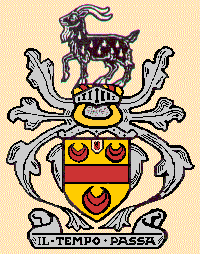
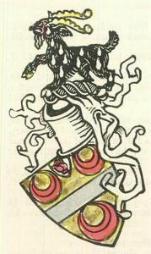
Notes on Heraldry
These notes are for people who, like me, know very little about heraldry. We need help, and I have called on Heather Child, Heraldic Design, for assistance. I relied on her book because it was explicitly about design, which is what I wanted to learn about. And it seemed to have a good pedigree in the form of the person writing the introduction.
Heraldry became established as a system during the second half of the 12th century, and by the middle of the 14th century the principle that no one could use a coat of arms already used by another was assumed in English courts. Robert Boynton's conflict, during the 1370s, with William de Aton over a coat arms is an example of arms ownership. At about the same time the monarch decided that arms were not to be used without permission from [and payment to] the monarch.
The blazon is a description of a coat of arms. The blazon of the North Riding Boynton family was: Or, a fess between three crescents gules. The Boyntons of Sedbury added a lion passant to the original coat of arms. Converting the blazon into an image is called emblazoning. Emblazoning requires an accurate representation of the blazon, but it still leaves latitude for the artist who is creating the coat of arms.
 |
 |
These are two emblazonings of the Boynton family crest -- one a bit rakish.
The heraldic figure may consist of a number of parts.
The coat of arms is described by the blazon and is usually displayed on a shield; the shield is the field on which the coat of arms is drawn. Other surfaces may be used as the field for displaying a coat of arms. In medieval England banners worn or carried by knights and horse trappings were used to display coats of arms, but they can be displayed on many different surfaces.
The crest "is a device which should be depicted as carried upon a helm in asociation with the mantling and crest wreath." [Child, p. 31] Very roughly, it is all the "stuff" above the shield. At some point the Boyntons added a crest, On a wreath a goat passant sa., guttee d'argent, beard, horns and hoofs or, to the coat of arms.
The supporters are creatures -- usually human or animal -- that flank the shield and uphold it.
Badges are supplementary devises that can be added to the coat of arms.
The motto is usually placed on a scroll beneath the shield.
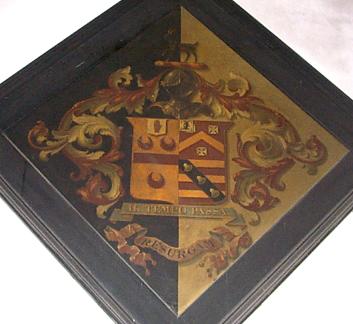 |
|
Crest in Church at Burton Agnes
|
A crest in the church at Burton Agnes illustrates the various parts of the crest. The shield is divided between Boynton on the left side and two coats of arms on the right side. Above the shield is a goat on a helmet. The wreath material surrounds the shield. The hand at the top of the Boynton side of the shield is a badge, and is used as the sign of a baronet. The mottoes are below the shield.
Shields come in a variety of shapes. Child illustrated a variety of shields that have been used in heraldry.
 |
The various Boynton coats of arms use different shapes for shields. These two shields were photographed at the church at Acklam. Even though the coats of arms are barely discernible the outline of the shields is clear.
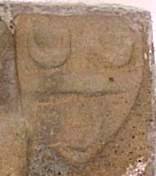 |
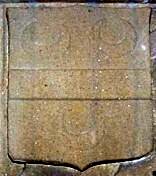 |
The shield from the Burton Agnes church is characterized as late 14th century. In the Acklam church both a 14th century shape and a late 14th century shape were used. Both were done in stone without color; at least there is no color in the 20th/21th centuries.
There are a number of ways to decorate the field on which the coat of arms will be placed. In one of the simplest an "ordinary" is used. An ordinary is a simple flat band superimposed on the shield. In the Boynton coat of arms the ordinary is a flat, straight line called a fess. A fess should occupy about one-third of the shield. The fess is seen in all three of the coats of arms above.
The colors used during the middle ages were simple and bold. There were two metals and five colors that could be used for the objects placed on the coat of arms.
Tincture |
Heraldic Name |
| Metals: | |
| Gold, yellow | Or |
| Silver, white | Argent |
| Colors: | |
| Blue | Azure |
| Red | Gules |
| Black | Sable |
| Green | Vert |
| Purple | Purpure |
| Charges represented in their natural colors are blazoned |
Proper |
Charges: Any objects placed on the field are called charges. In the Boynton coats of arms the three crescents are charges as is the lion passant for the Sedbury Boyntons.
Passant, as in lion passant, is defined as: walking, the dexter fore paw raised, the
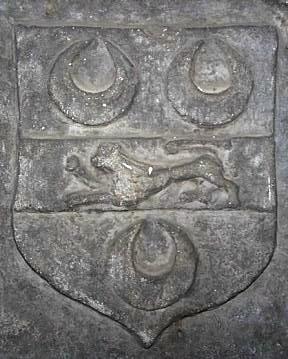 |
|
Gilling West Church
|
other three paws on the ground, head facing forward, tail curved over the back. This lion passant is taken from the Boynton wall piece in the Gilling West church.
The helmet on which the crest sits is specified by rank. The sovereign and relatives have a helmet of gold with five to seven golds bars shown facing out, full-faced. Baronets and knights have a vizored helmet of steel with the vizor raised and the helmet facing out, full-faced. Other ranks had helmets of a somewhat different shape and facing.
The crest could be almost anything. Since it was originally used with the helmet, it had to be light enough to be worn on a persons' head. The Boyntons chose the goat for their crest.
Augmentations were added to heraldic design in the 14th century. Augmentations were granted to commemorate historic events or outstanding exploits. Usually it would be an additional charge added to the coat of arms -- much as the badge can be added to the coat of arms.
The Boynton blazon: Or, a fess between three crescents gules
Every blazon begins with the tincture of the field of the shield unless the field is divided, then the character of the division precedes the mention of the color, e.g., 'Per pale or and gules'. Secondly, the principal charge or ordinary and its tincture are named. Then subsidiary charges and their tinctures and whether they are on or surrounding the principal charge or ordinary. [Child, p. 30]
The first element in the Boynton blazon is or, or gold, which is the color of the field of the shield. The background should be gold. The principal charge or ordinary of the shield is the fess. The subsidiary charges are the three crescents. Since both fess and crescents are to be gules, or red, that is specified only at the end of the blazon.
If you stick with the coat of arms, that is all there is to it. If you go with the crest it becomes slightly more elaborate. Boyntons, apparently, pursued simplicity; a noble pursuit.
 |
Heather Child (1965) Heraldic Design; a handbook for students, G. Bell and Son, London.